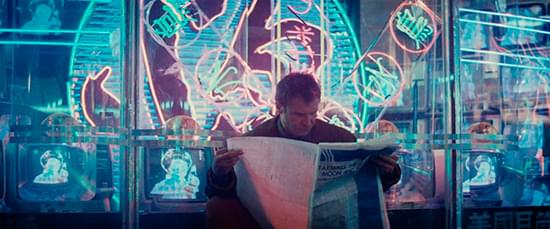

I love to see filmmakers’ visions of what tomorrow’s world will look like. Some get it right, some get it wrong but can anyone really say what our tech landscape will look like in 10 years’ time, and how would this influence internal communications?
OK, so I’m all ‘future-focussed’ after rewatching ‘Blade Runner 2049’ at the recently. “Indulge me”.
Let us consider that the original ‘Blade Runner’, while set in the year 2019, was actually made in 1982.
Director Ridley Scott and the production team’s vision of the future 2019 included both flying and driverless cars – not to mention near perfect humanoid Replicants – but it also featured newspapers, collections of printed photographs, chorded desk phones and public video payphones.
Flash forward to 2017 and the team working under director Denis Villeneuve for ‘2049’ had the challenge of imagining what Scott’s world would look like, 30 years on.
It was interesting to me that among the flying cars, personal remote CCTV drones and crystal-clear holograms, their prediction of this future didn’t seem to include printed materials or mobile phones.
Now, back to our timeline and our reality. While Elon Musk is busy perfecting all sorts of gadgets, we’re a long way off having a flying car, and the payphone is an idea practically relegated to the museum.
As an advanced civilisation, we have focussed our energies and innovations on the world of mobile technology.
The chances are, you’ll have heard someone say: “My four-year old is a whizz with the iPad”. To me, this statement represents the future of communication and therefore our internal communication habits.
There’s an entire generation of future, or even current, employees that have never known a life without the internet. These digital natives were born into a world of tech, which they instinctively understand and will immediately turn to as their source for their information and news.
However, there’s also a whole generation within many workforces who haven’t got the latest smartphone in their pockets. People who prefer to read a printed newspaper with a cup of tea, and, if honest, feel they wouldn’t bother reading anything if they had to log on to a ‘new-fangled’ device to get it.

So, here’s my question: “Is the future a purely digital one?”
To find an answer, we only have to look to the external publishing world. There are a multitude of daily, weekly and monthly publications that are bought and sold in print, all of which have an super strong online presence – some have subscription-only and paid content too.
This online presence backs up and complements their printed offering, but doesn’t change or replace the reader experience – it enhances it.
The line between the two platforms has become blurred, and that’s how I believe it should be. The two should inform, develop and drive each other to be stronger, rather than sit as two separate channels. They can talk to each other – your printed and digital platforms can signpost and create content for both audiences, in tandem.

From a design point of view, I would typically say any website created today should be designed as a fully responsive build. I would preach that it should morph and break down to fit today’s mobile devices. It should cater for an audience that’s looking to access information at any time, but at the same time offer a rich experience when viewed on a desktop or tablet. Our tablets and phones are starting to get bigger and our readers are looking for an experience that is, in many ways, reminiscent of print.
For a moment, let’s consider an alternative future where the smartphone as we know it may be on its way out.
Along with a plethora of other available wearable tech, some smartwatches don’t even require a phone. Would this mean that worrying about whether colleagues will read your content on their phones will become a thing of the past? Imagine if your phone became nothing more than a tiny badge on your lapel and your content was projected, via a holographic display, into the very air before you. Imagine that Siri or Alexa became a photo-real, visible personality with a real human face who looked after everything from your contacts to your health. Scary or exciting? That’s up to you.

When deciding on a route for your communications, the one absolute recommendation we make is that you consult your people and assess what works for them, and importantly, what doesn’t.
Using focus groups to find the right solutions will be your key to success in making sure you have the right strategy in place. One size rarely fits all, so we recommend you take the opportunity to understand your company’s communication habits and preferences before choosing to shake things up.